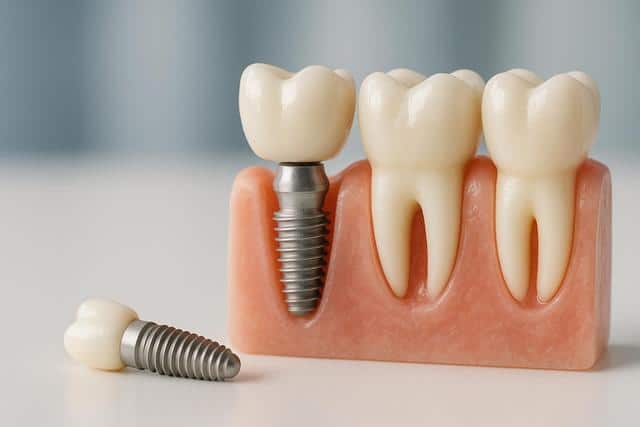
All you need to know about Dental Implants
What exactly is a dental implant?
A dental implant is a small post surgically placed in the jawbone to replace a missing tooth root. Over time, bone fuses to this post (a process called osseointegration), allowing a dentist to attach an abutment and a custom crown, bridge, or denture on top. In the U.S., endosseous (in‑bone) implants are regulated as Class II medical devices with specific testing and labeling requirements [1]. For patients comparing options, the American Dental Association’s consumer guidance describes implants as a long‑term tooth‑replacement approach intended to blend with natural teeth [2].
Pro Tip: Ask your provider to document implant brand, size, lot number, and restorative components in your record and in a take‑home summary. An ADA data standard exists to make future maintenance easier if you ever move or change dentists [3].
Implant materials and components (titanium vs. zirconia)
Most implants are titanium or titanium‑alloy because of favorable strength, osseointegration, and long clinical track records [1]. Zirconia (ceramic) implants exist for patients seeking metal‑free options. Current randomized and systematic reviews suggest broadly comparable short‑term tissue health, with several analyses showing higher 1‑year survival and less marginal bone loss for titanium compared with zirconia, while also noting limited sample sizes and study heterogeneity [4] [5] [6]. In practical terms, either material can be appropriate depending on anatomy, esthetic needs, and clinician experience.
| Aspect | Titanium | Zirconia |
|---|---|---|
| Clinical track record | Extensive multi‑decade data | Smaller evidence base; growing |
| 1‑year survival (trials/meta‑analyses) | Generally higher, with less marginal bone loss in several reviews | Comparable in some studies; others show lower survival and more bone loss [5] |
| Esthetics at gumline | Usually excellent; gray shine‑through rare with proper soft‑tissue thickness | White substrate may reduce shine‑through in thin tissue zones |
| Allergy/metal‑free preference | Rare hypersensitivity reported | Metal‑free option for select patients |
Who is a good candidate?
Ideal candidates have sufficient jawbone, healthy gums, and no uncontrolled medical conditions that interfere with healing. A major U.S. clinic summarizes typical criteria (adequate bone or graftability, healthy oral tissues, and commitment to several months of treatment) [7]. If bone is thin after long‑standing tooth loss, guided bone regeneration or sinus augmentation may be recommended; healing for grafts can take several months before implant placement [8].
Timing matters too. Placing an implant immediately after extraction, early (weeks later), or after full healing can all be appropriate. Evidence reviews indicate similar survival between immediate and delayed approaches, with a trend toward more early complications when placing immediately in some analyses [9] [10].
Pro Tip: If you smoke, pausing tobacco before and after surgery significantly reduces early implant failure risk; meta‑analysis shows roughly doubled odds of early failure in smokers, especially in the upper jaw [11].
Procedure roadmap: from consult to final tooth
While individual plans vary, this is a common sequence:
1) Consultation and 3D imaging to assess bone and nerves; 2) Extraction (if needed) with or without grafting; 3) Implant placement under local anesthesia (plus optional sedation); 4) Healing (osseointegration) over several weeks to months; 5) Abutment connection and digital or traditional impressions; 6) Final crown/bridge/denture delivery and bite adjustments [2] [7].
Same‑day teeth (immediate loading) can be appropriate when primary stability is excellent and bite forces are controlled; your surgical team will advise whether a temporary tooth on the day of surgery is prudent in your case [9].
Pro Tip: Before surgery, confirm whether your provisional tooth is removable or fixed, how you’ll eat during healing, and the estimated timeline for the final restoration. These comfort details matter just as much as the surgical plan.
Success rates, risks, and long‑term maintenance
Institutional outcomes consistently report high integration rates: for example, one U.S. center documented a 95% implant integration success in 2023, aligning with international averages [12]. That said, implants require ongoing home care and professional maintenance. In population‑level research using standardized definitions, peri‑implantitis (inflammatory bone loss around implants) affects roughly 1 in 5 patients over time, with higher rates in those not in maintenance care and in smokers; estimates vary with diagnostic cutoffs and follow‑up duration [13] [14] [15]. Patients with a history of periodontitis also carry elevated risk and may need closer follow‑up [16].
Regular cleaning around implants (brushing, interdental tools, water flossers) and 3–6 month professional maintenance help minimize inflammation and detect issues early [17] [16]. An endodontic specialty summary also cautions that, in patients previously treated for periodontal disease, long‑term implant loss can outpace tooth loss—another reason case selection and maintenance matter [18].
Expert note: As the ADA explains, “Dental implants are a popular and effective way to replace missing teeth.” [2]
What do dental implants cost in the United States?
Because plans differ by anatomy, materials, lab work, and region, prices vary widely. Current consumer cost guides and fee surveys commonly show:
| Treatment | Typical U.S. price range | What the range usually includes |
|---|---|---|
| Single‑tooth implant (implant + abutment + crown) | $3,000–$6,000 | Diagnostic workup, implant placement, abutment, and a custom crown; advanced grafting or IV sedation usually add cost [19] [20] |
| Implant‑supported bridge (spans multiple teeth) | $10,000–$16,000 | Two or more implants plus a multi‑unit bridge; varies with span length and materials [19] |
| “All‑on‑4/6” fixed full‑arch (per arch) | $15,000–$25,000+ | 4–6 implants, provisional fixed bridge, and final bridge after healing; premium materials raise cost [19] |
For a ZIP‑code‑specific estimate (and to compare nearby areas), use a neutral, non‑promotional price lookup such as FAIR Health Consumer’s dental cost tools [21] [22] [23]. Note that the ADA’s fee survey is no longer published as a public reference, so rely on up‑to‑date consumer tools and written treatment estimates from clinics [24]. Historical code‑level fee snapshots (e.g., D6010 implant placement, D6057 custom abutment, D6058 crown) can be found in past surveys but may not reflect 2025 prices in your area [25].
Pro Tip: Ask for an itemized plan listing CDT codes (e.g., D6010, D6056/D6057, D6065/D6066) and all potential add‑ons (grafting, membranes, CBCT, sedation). It makes apples‑to‑apples comparisons far easier [23].
Insurance and Medicare: what’s typically covered?
Many private dental plans treat implants as a major service with partial coverage caps and annual maximums, or exclude them altogether; always request pre‑authorization. For seniors, Original Medicare generally excludes routine dental, but as of January 1, 2024 and through subsequent rulemaking, Medicare can pay for certain dental services that are inextricably linked to covered medical care (for example, addressing oral infection before specific cancer therapies). CMS details these rules and billing mechanics—including 2025 KX‑modifier requirements to document medical necessity and care coordination—on its coverage pages and guidance portals [26] [27] [28] [29]. Medicare Advantage plans may advertise dental benefits, but coverage details, annual caps, and exclusions vary; compare carefully during open enrollment.
Another frequent point of confusion involves patients with orthopedic joint replacements. Updated 2024 orthopedic guidelines inform antibiotic decisions around dental care; your dental and medical teams will coordinate personalized recommendations [30] [31].
Comparing common implant choices
Use this quick comparison to frame your consult questions:
| Scenario | Often chosen | Typical timeline | Notes |
|---|---|---|---|
| 1 missing molar | Single implant + crown | 3–6 months from placement to final | High long‑term survival when well maintained [12] |
| 3 missing teeth in a row | Two implants + 3‑unit bridge | Similar | Span length influences cost and design [19] |
| Most or all teeth missing (one arch) | 4–6 implants + fixed full‑arch bridge (non‑removable) | Often staged over months; immediate provisional possible in some cases | Higher upfront cost; strong chewing efficiency [19] |
| Denture moves while eating | 2–4 implants + overdenture (removable) | Weeks to months | Value‑forward stability boost; ongoing clip/liner maintenance |
Care and habits that protect your investment
Daily plaque control and professional maintenance are non‑negotiable. Use soft‑bristle brushing, low‑abrasive paste, and interdental tools around implants; water flossers can help reduce plaque in hard‑to‑reach spots. Schedule recalls every 3–6 months based on your risk profile [17] [16].
Pro Tip: If you’ve had periodontitis in the past, ask your dentist about a personalized maintenance schedule and early‑warning monitoring (bleeding scores, pocket depths, and calibrated x‑rays) given higher long‑term peri‑implantitis risk [14].
How to choose a qualified provider
Look for clinicians with advanced training who routinely plan and place/restore the type of implant you need. Professional organizations maintain patient education and directories to help you evaluate credentials and find nearby clinicians [32]. The ADA’s Find‑a‑Dentist tool supports searches by ZIP code, specialty, languages, insurance, and distance filters [33].
Pro Tip: Take two written treatment plans—ideally from clinicians who use different labs or systems—and compare specifics (components, materials, number of visits, provisional approach, warranty terms). Combine this with a neutral cost lookup for your ZIP to see whether the quote aligns with your market [21] [22].
Find local and online services
Use these simple widgets to move from research to action:
Local implant dentist search (by ZIP):
Search ADA Find‑a‑Dentist and enter your ZIP to filter for implant services, specialty, and insurance [34].
Book online now:
Check live availability on Zocdoc to schedule a consultation with an in‑network dentist in your area [35].
Dental Implants: Frequently Asked Questions
How long do implants last?
With good home care and professional maintenance, many implants function for decades. Institutional series report around 95% early integration success, with long‑term survival influenced by risk factors like smoking and prior gum disease [12] [13].
Are same‑day implants right for me?
Sometimes. When bone quality and initial stability are excellent, immediate placement and even immediate provisional teeth may be reasonable; evidence shows similar survival to delayed in selected cases but notes a higher rate of early complications in some analyses [9] [10].
Will insurance or Medicare cover it?
Private dental plans vary—some cover part of the surgical and restorative steps up to annual maximums. Original Medicare generally excludes implant dentistry, but as of 2024–2025, Medicare can pay for dental services integral to specific covered medical care, with documentation and new modifier rules. Check CMS and your clinicians for case‑specific guidance [26] [27] [29].
What everyday habits protect implants?
Brush twice daily, clean between teeth and around implants, and see your dental team every 3–6 months. If you clench or grind, discuss a protective night guard. Smoking cessation and blood‑sugar control (if you have diabetes) also help minimize complications [17] [11].
Recap and next steps
Dental implants are among the top options for replacing missing teeth, offering stable function and a natural look when planned thoughtfully and cared for consistently. To move forward confidently, combine a detailed consultation (with imaging and a written, code‑level plan) with an objective local price check and a maintenance plan tailored to your risk factors. When you’re ready, use the local ZIP search to find clinicians near you and book an online consultation to compare approaches.
Websources
- FDA: Root‑form endosseous dental implants – Class II special controls
- ADA MouthHealthy: Dental implants (patient info)
- ADA Standard No. 172: Minimal dental implant data set
- Systematic review: Zirconia vs. titanium implants (2022)
- Meta‑analysis (2025): Two‑piece zirconia vs titanium, 1‑year outcomes
- Systematic review: Titanium, Ti‑Zr, and zirconia implants
- Mayo Clinic: Dental implant surgery overview
- Cleveland Clinic: Dental bone graft
- Systematic review/meta‑analysis: Immediate vs delayed placement
- Cochrane review: Timing after extraction
- Meta‑analysis: Smoking and early implant failure (2024)
- Cleveland Clinic outcomes: Implant integration success
- BMC Oral Health: Peri‑implantitis prevalence (2022)
- Systematic review: Peri‑implantitis risk factors
- Systematic review: Prevalence of peri‑implant diseases
- American Academy of Periodontology: Peri‑implant diseases
- ADA MouthHealthy: Daily oral care
- AAE summary: Implants vs teeth in periodontitis patients
- BetterCare (2024): U.S. implant cost guide
- CostHelper: Dental implant cost ranges
- FAIR Health Consumer: Dental cost lookup (overview)
- FAIR Health: Shopping for shoppable services
- FAIR Health: Questions to ask/using estimates
- ADA HPI: Dental care market and fee survey note
- ADA HPI (archival 2020 fee tables on Scribd)
- CMS: Medicare dental coverage (updated 2025)
- ADA News (Nov 2023): CMS expands dental payment
- ADA News (Nov 2024): 2025 Medicare final rule
- HHS Guidance: Medicare dental coverage (KX modifier)
- AAID: Consumer implant information and directory
- ADA Find‑a‑Dentist (patient directory)
- ADA News (Apr 2025): Redesigned Find‑a‑Dentist
- Zocdoc: Book a dental implant consultation


